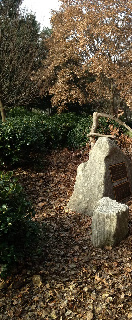User:Rebeka Winkler/Notebook/Biology 210 at AU
January 28th, 2015 Identifying Algae and Protists
Purpose: Examining and Identifying microorganisms in the Algae and Protist category.
Materials and Methods: The hay sample, form the precious lab, was used to make two wet mounts. One wet mount was from taken from the portion near the berry and the other was taken from the top to middle of the soil, water sample. The wet mounts were then examined under the microscope. Using a dichotomous key, a total of six microorganisms were identified.
Data and Observations:
Upon the opening of the hay sample, that had been brewing in the lab for a week, we noted the smell was something like stagnant water. As shown in figure one and two, the soil had settled to the sides and bottom of the jar.
Figure 1:
 Figure 2:
Figure 2:
 G_42
Unlike other samples, there was no present mold or green shoots. After basic observations, the two samples were taken and made into wet mounts. By taking a sample closer to and farther away from vegetation we can see if algae and protists differ based on their habitat. One micro-organism closer to vegetation, and therefor direct food source, may be larger than the same micro-organism away from vegetation.
From the wet mount of the sample from the top or middle of the infusion, the identified organisms were Burasaia Truncatella, Gonium, and Pelomyxa (Figure 3). All three were motile, though the Pelomyxa was much slower than the others. I could not tell if they were photosynthesizing. The Burasaia Truncatella was larger than the other two.
Figure 3:
G_42
Unlike other samples, there was no present mold or green shoots. After basic observations, the two samples were taken and made into wet mounts. By taking a sample closer to and farther away from vegetation we can see if algae and protists differ based on their habitat. One micro-organism closer to vegetation, and therefor direct food source, may be larger than the same micro-organism away from vegetation.
From the wet mount of the sample from the top or middle of the infusion, the identified organisms were Burasaia Truncatella, Gonium, and Pelomyxa (Figure 3). All three were motile, though the Pelomyxa was much slower than the others. I could not tell if they were photosynthesizing. The Burasaia Truncatella was larger than the other two.
Figure 3:
 At the berry, we identified Copidium Sp., Blepharism Sp, and Chlamydomanas (Figure 4). The Blepharism Sp. was interesting as it was long, non-motile, and bring pink completely unlike the other identified samples from the same wet mount. The Copidium Sp. seemed to dodge in and out of view under the protection of particles from the berry. Of the three, the Copidium Sp. was the smallest.
Figure 4:
At the berry, we identified Copidium Sp., Blepharism Sp, and Chlamydomanas (Figure 4). The Blepharism Sp. was interesting as it was long, non-motile, and bring pink completely unlike the other identified samples from the same wet mount. The Copidium Sp. seemed to dodge in and out of view under the protection of particles from the berry. Of the three, the Copidium Sp. was the smallest.
Figure 4:

Conclusions and Future Directions: From the original hey infusion, We prepared for next week's lab by making serial dilutions. In each tube, we placed 100 mLs of sterile broth. In the first tube, we measured 100 uLs of the hay infusion and placed 100 uLs on a plate with and without Tetracycline. From the first tube, we measured another 100 uLs and placed it in the second tube, thus diluting the solution. The process was repeated four times so that a total of eight plates were made. A diagram of serial dilution is shown below (Figure 5) File:Serial dillution .JPG
RW
January 24th, 2015 Tall Bushes at the Amphitheater
Purpose: Observing, testing, and inspecting a transect for abiotic and biotic components.
Materials and Methods: A 20 by 20 meter transect will be inspected throughout the assignment. The transect, "tall bushes" is a hilly area directly next to the American University amphitheater. Once at the transect, we took a 50 mL sample of the soil near a discovered rat trap, a berry, and a leaf. Figure 1 is an illustrated map of the 20 by 20 transect. The 50mL sample was then used in a Hay Infusion in which 10 to 12 grams of the soil sample was placed in a plastic jar and mixed with .1 gram of dried milk and 500 mL of sterilized water.
Figure 1:
Data and Observations: The transect is on a hill and is covered in foliage either fallen on the ground, in the round bushes, or in trees behind the bushes. Upon further examination, we discovered a rat trap and that the bushes were growing berries. A rock with a plaque marks the area. The following images are of the area.
Biotic (live) components include squirrels, bushes, trees, birds, and insects. The squirrels and birds moved around the transect in the bushes, trees, or on the floor.The trees are behind the bushes, or Northern in relation to them. Insects were found in accordance to their webs, under the bushes. Abiotic (non-living components) include rocks, a plaque, a rat trap, dirt, and snow. The rocks, or mainly one rock, is in the Southeastern corner of the transect and on it is a plaque. The rat trap was found a few feet behind the rock. As of the week of January 14th, snow bordered the transect.
Conclusions and Future Directions: We will continue to monitor the transect so that we can see it in other types of conditions. I predict that we will see more wildlife and more evidence of colder weather like fallen leaves and browning bushes as the assignment continues.
RW
